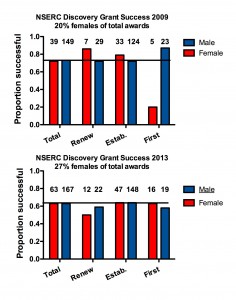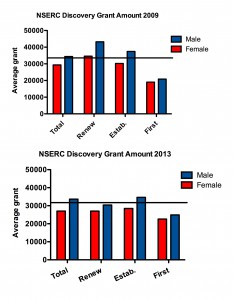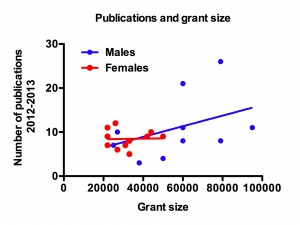In Maclean’s Magazine on November 25, 2015 Professor Lee Smolin of the Perimeter Institute for Theoretical Physics, an adjunct professor of physics at the University of Waterloo, and a member of the Royal Society of Canada, wrote an article “Ten Steps to Make Canada a Leader in Science” (http://www.macleans.ca/politics/ottawa/ten-steps-to-make-canada-a-leader-in-science/ ). Some of the general points in this article are very good but some seem to support the view of science as big business and that leaves ecology and environmental science in the dust. We comment here on a few points of disagreement with Professor Smolin. The quotations are from the Maclean’s article.
- Choose carefully.
“Mainly invest in areas of pure science where there is a path to world leadership. This year’s Nobel prize shows that when we do this, we succeed big.” We suggest that the Nobel Prizes are possibly the worst example of scientific achievement that is currently available because of their disregard for the environment. This recommendation is at complete variance to how environmental sciences advance.
- Aim for breakthroughs.
“No “me-too” or catch-up science. Don’t hire the student of famous Prof. X at an elite American university just because of the proximity to greatness. Find our own path to great science by recruiting scientists who are forging their own paths to breakthroughs.” But the essence of science has always been replication. Long-term monitoring is a critical part of good ecology, as Henson (2014) points out for oceanographic research. But indeed we agree to the need to recruit excellent young scientists in all areas.
- Embrace risk.
“Learn from business that it takes high risk to get high payoff. Don’t waste money doing low-risk, low-payoff science. Treat science like venture capital.” That advice would remove most of the ecologists who obtain NSERC funding. It is one more economic view of science. Besides, most successful businesses are based on hard work, sound financial practices, and insights into the needs of their customers.
- Recruit and invest in young leaders-to-be.
“Be savvy and proactive about choosing them…. Resist supporting legacies and entitlements. Don’t waste money on people whose best work is behind them.” We agree. Spending money to fund a limited number of middle aged, white males in the Canadian Excellence in Research Chairs was the antithesis of this recommendation. See the “Folly of Big Science” by Vinay Prasad (2015). Predicting in advance who will be leaders will surely depend on diverse insights and is best evaluated by giving opportunities for success to many from which leaders will arise.
- Recruit internationally.
“Use graduate fellowships and postdoctoral positions as recruitment tools to bring the most ambitious and best-educated young scientists to Canada to begin their research here, and then target the most promising of these by creating mechanisms to ensure that their best opportunities to build their careers going forward are here.” This seems attractive but means Canadian scientists have little hope of obtaining jobs here, since we are < 0.1% of the world’s scientists. A better idea – how about Canada producing the “best-educated” young scientists?
- Resist incrementalism.
“If you spread new money around widely, little new science gets done. Instead, double-down on strategic fields of research where the progress is clear and Canada can have an impact.“ Fortin and Currie (2013) show that spreading the money around is exactly the way to go since less gets wasted and no one can predict where the “breakthroughs” will happen. This point also rests on one’s view of the world of the future and what “breakthroughs” will contribute to the sustainability of the earth.
- Empower ambitious, risk-taking young scientists.
“Give them independence and the resources they need to develop their own ideas and directions. Postdocs are young leaders with their own ideas and research programs”. This is an excellent recommendation, but it does conflict with the recommendation of many universities around the world of bringing in old scientists to establish institutes and giving incentives for established senior scientists.
- Embrace diversity.
“Target women and visible minorities. Let us build a Canadian scientific community that looks like Canada.” All agreed on this one.
- Speak the truth.
“Allow no proxies for success, no partial credit for “progress” that leaves unsolved problems unsolved. Don’t count publications or citations, count discoveries that have increased our knowledge about nature. We do research because we don’t know the answer; don’t force us to write grant proposals in which we have to pretend we do.” This confounds the scientists’ code of ethics with the requirements of bureaucracies like NSERC for accounting for the taxpayers’ dollars. Surely publications record the increased knowledge about nature recommended by Professor Smolin.
- Consider the way funding agencies do business.
“We scientists know that panels can discourage risk-taking, encourage me-too and catch-up science, and reinforce longstanding entitlements and legacies. Such a system may incentivize low-risk, incremental work and limit the kind of out-of-the-box ideas that….leads to real breakthroughs. So create ambitious programs, empower the program officers to pick out and incubate the brightest and most ambitious risk-takers, and reward them when the scientists they invest in make real discoveries.” What is the evidence that program officers in NSERC or NSF have the vision to pick winners? This is difficult advice for ecologists who are asked for opinions on support for research projects in fields that require long-term studies to produce increases in ecological understanding or better management of biodiversity. It does seem like a recipe for scientific charlatans.
The bottom line: We think that the good ideas in this article are overwhelmed by poor suggestions with regards to ecological research. We come from an ecological world faced with three critical problems that will determine the fate of the Earth – food security, biodiversity loss, and overpopulation. While we all like ‘breakthroughs’ that give us an IPhone 6S or an electric car, few of the discoveries that have increased our knowledge about nature would be considered a breakthrough. So do we say goodbye to taxonomic research, biodiversity monitoring, investigating climate change impacts on Canadian ecosystems, or investing in biological control of pests? Perhaps we can add the provocative word “breakthrough” to our ecological papers and media reports more frequently but our real goal is to acquire greater insights into achieving a sustainable world.
As a footnote to this discussion, Dev (2015) raises the issue of the unsolved major problems in biology. None of them involve environmental or ecological issues.
Dev, S.B. (2015) Unsolved problems in biology—The state of current thinking. Progress in Biophysics and Molecular Biology, 117, 232-239.
Fortin, J.-M. & Currie, D.J. (2013) Big science vs. little science: How scientific impact scales with funding. PLoS ONE, 8, e65263.
Prasad, V. (2015) The folly of big science. New York Times. October 2, 2015 (http://www.nytimes.com/2015/10/03/opinion/the-folly-of-big-science-awards.html?_r=0 )
Henson, S.A. (2014) Slow science: the value of long ocean biogeochemistry records. Philosophical Transactions of the Royal Society of London A: Mathematical, Physical and Engineering Sciences, 372 (2025). doi: 10.1098/rsta.2013.0334.


